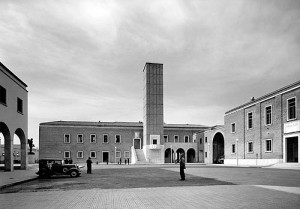In Bosworth’s article “Everyday Mussolinism: Friends, Family, Locality and Violence in Fascist Italy”, ((Bosworth, R. J. B. “Everyday Mussolinism: Friends, Family, Locality and Violence in Fascist Italy.” Contemporary European History 14, no. 1 (February 2005): 23-43. http://www.jstor.org/stable/20081243.)) the pervasive and totalitarian nature of the Italian Fascist regime is brought into question. Bosworth argues that even the Duce himself was aware of how ineffective his government was at implementing policy into change of everyday behavior. An anti-Fascist under current developed and was reoccurring without being institutionally controlled. ((Bosworth, Everyday Mussolinism, 28)) By examining multiple individual cases and examples, Bosworth successfully shows the multitude of ways the Italian public found opportunities to undermine Mussolini’s supposedly complete system of statist control. His view of the limited forcefulness of Fascism is summarized as, “a fragile influence, an ideology and a system which could readily enough be evaded. Its announced intention radically and permanently to change the Italian present, past and future was a long way from realization.” ((Bosworth, Everyday Mussolinism, 27)) Bosworth admits that the historiography in the field of the ordinary life of citizens under Italian Fascism is limited. He cites the works of Stalinist historian Fitzpatrick and Nazi historian Peukert as examples of quality writing including case studies of day to day existence concerning the Soviet Union and Germany that are not comparably present in Italian historical writing. ((Bosworth, Everdyday Mussolinism, 25))
In more ways than one, Mussolinism comes across as the weakest of the European totalitarian regimes of the 1930s. Especially in comparison with the clear danger present under Nazism and Stalinism, each which utilized a terrorist state police force, surveillance system, and camp system, Fascism seems the gentler of the three in term of prosecution of enemies of the state. In fact, Bosworth presents the Facist regime as so corrupted that it was actually easily manipulated by the populace. In Hitler’s Germany and the Soviet Union, it was completely the opposite, with the public being controlled by the powerful administration.
In all three systems violence, fear, and nationalism was a reoccurring theme. However, the levels of public fear were clearly the lowest in Fascist Italy. In addition, trying to unify a country, as each regime did, while also attempting to create a hyper-controlled state was contradictory to the extreme and eventually led to the downfall of each dictatorship. The majority of the public eventually realized that the government could not be trusted with such highly opposing domestic goals. Bosworth gives the sense that this opinion was highest and most vocally expressed in Italy, where very few people took Fascism seriously and most attempted to carry out their lives and families’ traditions as normally as possible. Although Mussolini hoped to instill a strong, masculine, national Italian public life, his citizens rejected his hopes and emasculated the Fascist regime by retaining their distinct, individual, and regional Italian identities in contradiction with Mussolini’s proposed ‘one Italy’. ((Bosworth, Everday Mussolinism, 41)) If you were a citizen of an oppressive regime, under what circumstances and / or threats would it take for you to change your way of life or beliefs to appease the state?

